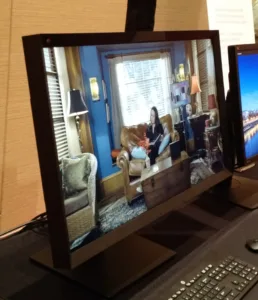Greg Staten, HP’s DreamColor Solutions Architect, used ShowStoppers to show off his new baby – the 31″ HP DreamColor Z31x Studio monitor. This is a 4K (4096 x 2160) SDR monitor with wide color gamut and built-in calibration sensor for use in visual effects, animation studios, production and post production houses. HP thinks the performance matches competitors, but at a much more attract price point of $4K.
Staten explained that their goal was to get the best contrast they could out of an IPS panel, but they found that recent versions of the technology have cost reduced production – and compromised contrast performance. They therefore worked with a panel provider to go back to the original IPS designs and processes (like UV photo alignment and a good polarizer stack) for this new monitor, which delivers a contrast of 1500:1. Peak luminance is 250 cd/m². Blacks and colors are also said to be consistent with viewing angle, especially in the vertical direction because a supervisor will often stand behind a seated VFX artist to review the work.
Color performance is great too with the specs being 100% of sRGB, 100% of BT.709, 100% of AdobeRGB, 99% of DCI-P3, 80% of BT.2020. They do this using a new LED backlight technology with phosphors. Staten could not reveal much about the technology other than it involves a sputtering process. The slight coverage deficit for DCI-P3 is in the red where they could not quite get to the full primary.
Staten noted that they looked at creating the wide color with quantum dots, but they could not find a supplier with a Cd-free solution when they did their investigations. They also determined that the QD solution was less efficient than their phosphor solution, which is a bit at odds with what the QD folks will say. And, if you want to push performance to the 1000 cd/m² range for a HDR monitor, they became concerned about aging of the QD film. This latter is an interesting point. Clearly QD-film-based TVs exist with 1000 cd/m² of peak brightness, but the sets don’t hold high brightness images for long periods of time – they lower the brightness. This is a thermal management concern which I assumed was related to the LED heat, but it may also be a QD film heating concern as well. In a professional VFX or post production environment, users need to be able to hold images static for long periods, so the use of QD in these monitor for HDR may be problematic at this time.
Staten also said they actually built in a small KVM module into the monitor. Why? – Because many artists have two computers, a Linux box with their animation/compositing app and a Windows box with Adobe Photoshop or internet access. And each has its own monitor. By building in the KVM to the monitor, a few keystrokes allow fast switching between sources, and saves the cost of an external KVM.
Another nice feature is the pixel for pixel option. That means a 1080 source is not scaled to fit the monitor, but matched to the higher resolution of the monitor. In other words, there is a direct mapping of each 1080p source pixel to four pixels on the displays so no scaling artifacts are introduced. Staten thinks other reference monitors scale and can therefore introduce some artifacts.
Finally, the monitor features a built-in sensor that swings down from the top of the display. Calibration can be automated to optimize performance, and the sensor can be aligned to a higher fidelity sensor from time to time as well. Staten says they can automate calibration to all presets, something the competition doesn’t do.
The company also introduced the HP DreamColor Z24X G2 displays are enabling artists, photographers and filmmakers for $559. The HP Z31x DreamColor Studio Display is scheduled to be available later this year for $3,999. – CC

